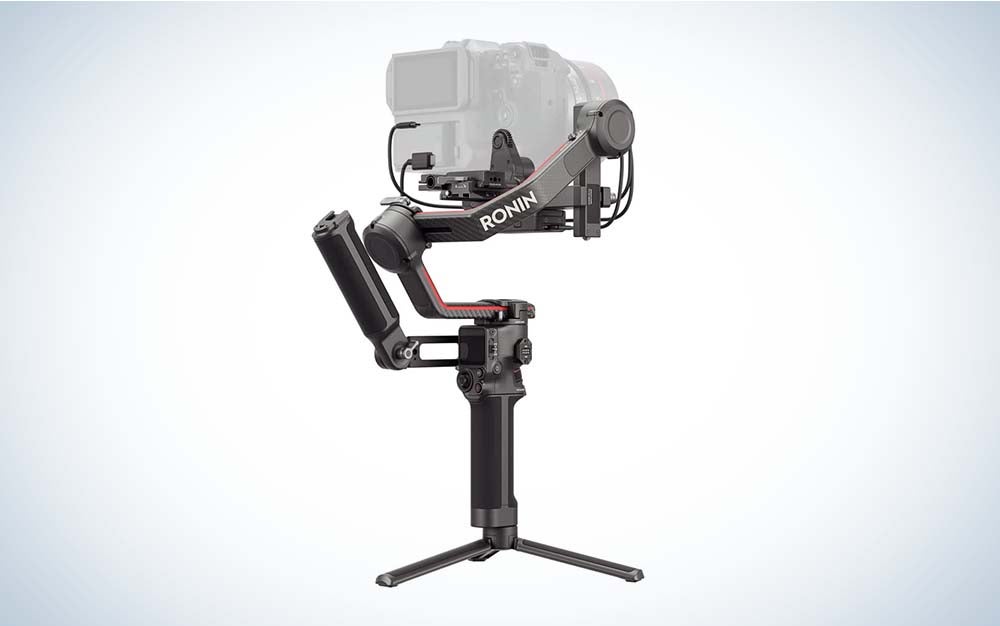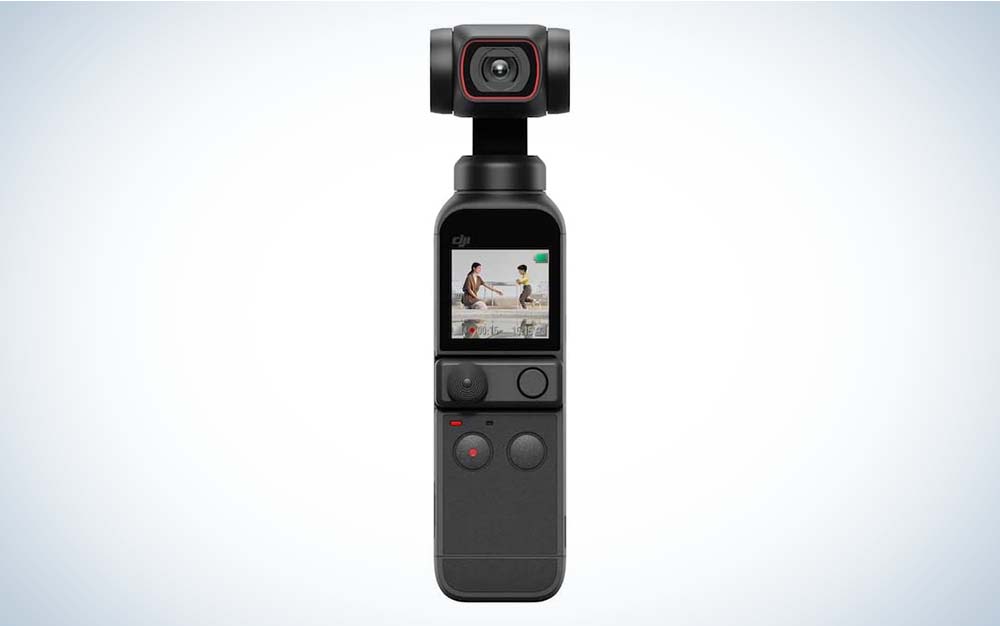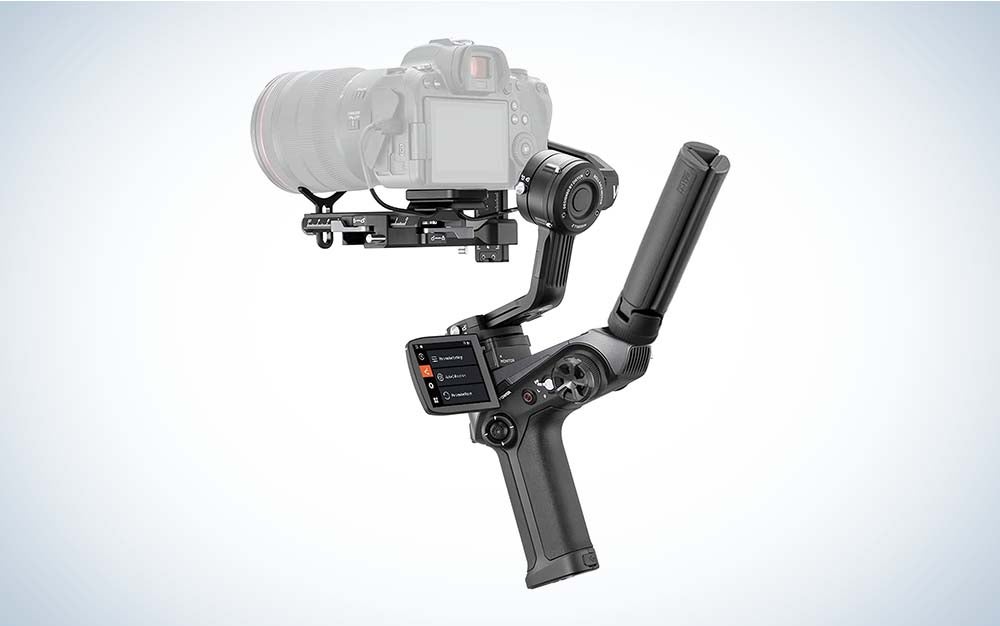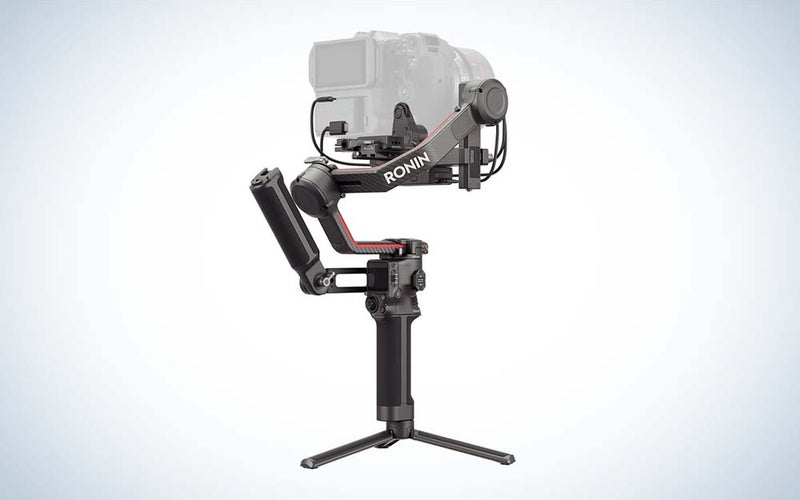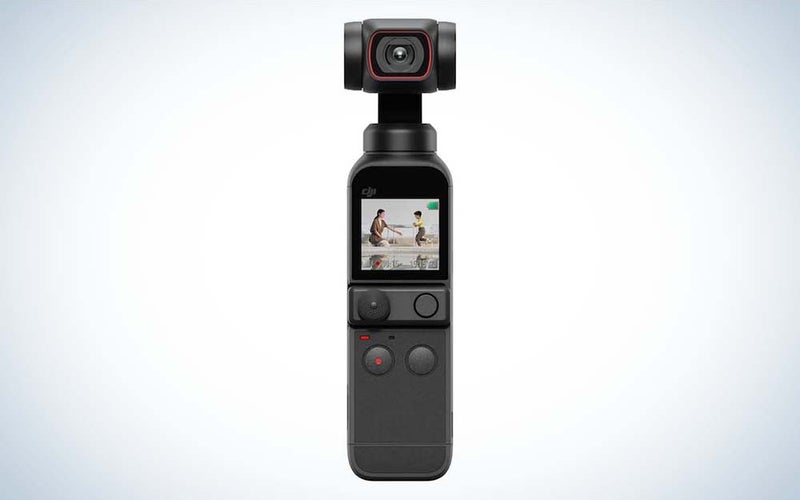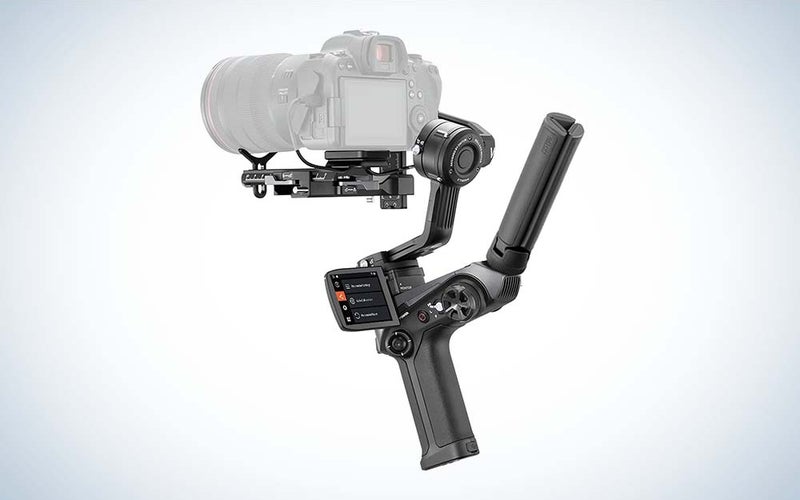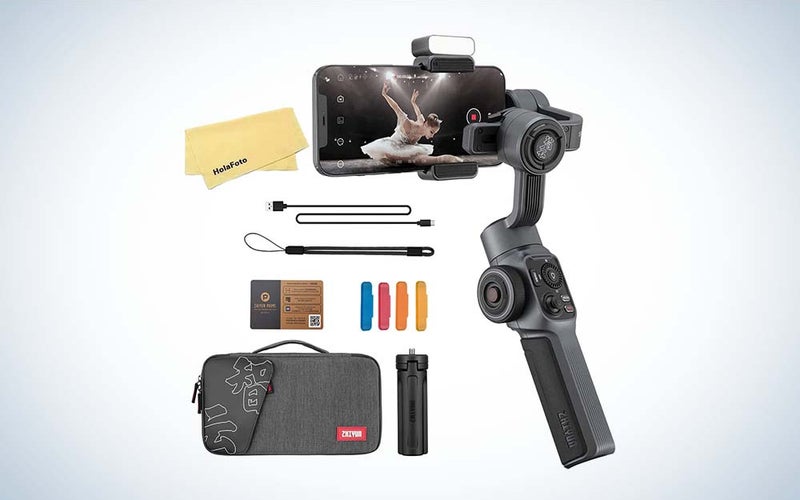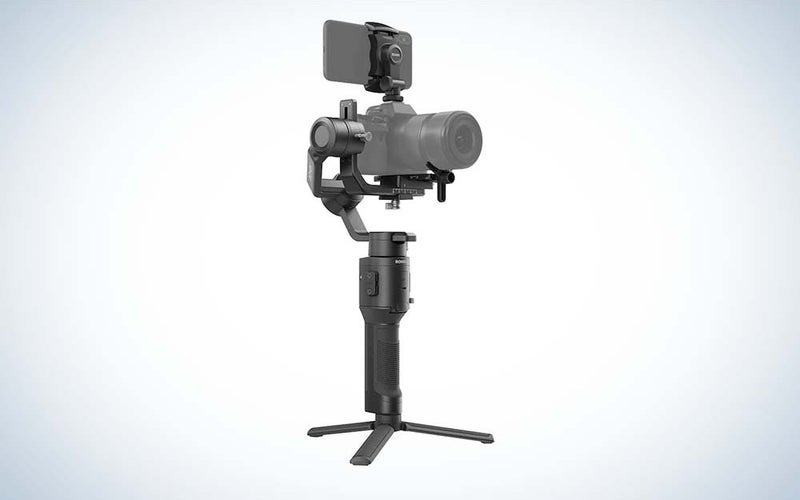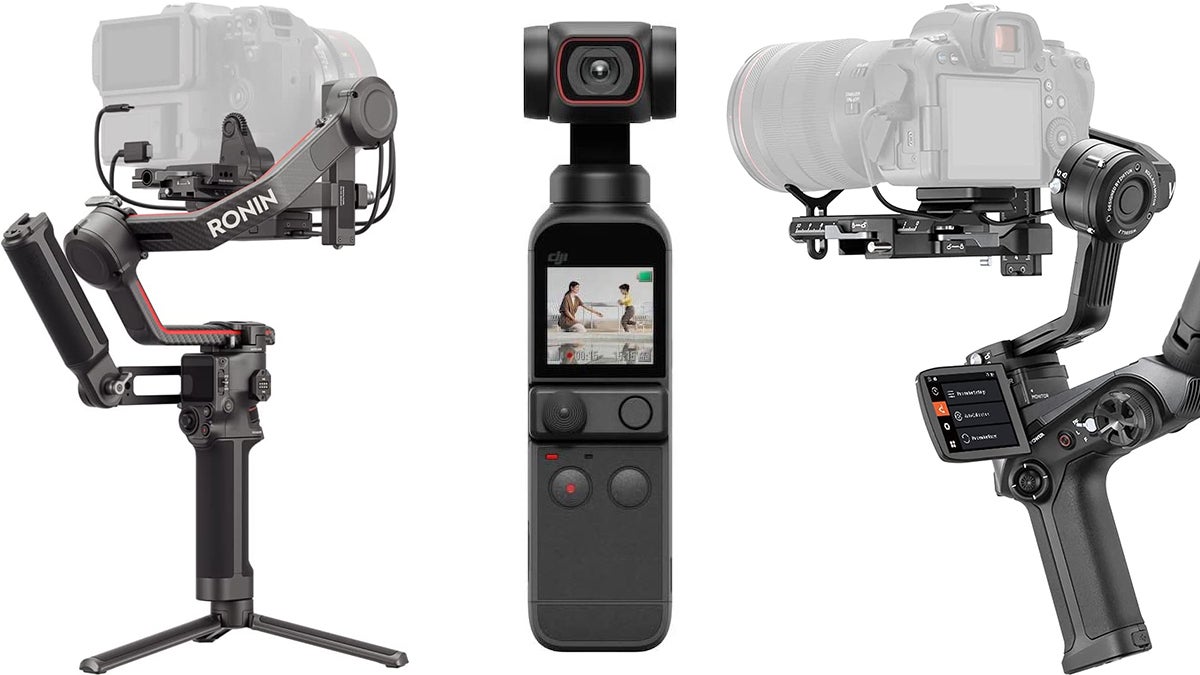
Gimbals hold your camera steady so you can shoot buttery-smooth, cinema-ready footage while on the move. Gimbals are a type of hand-held support system that stabilizes your camera on three axes—tilt, pan, and roll. Once you’ve attached your camera to the gimbal’s main arm, computer-controlled, brushless motors make lightning-fast, minute adjustments every time you move. This prevents the dreaded shaky-cam that often plagues so many hand-held shots.
Camera operators use gimbals when following a character as they move through a scene. Sometimes they’re used to achieve smooth point-of-view shots. You’ll find them on stage with bands when recording live concerts. Gimbals can be mounted on jibs, built into drones, and are often attached to cars. The ways of using them are limited only by your imagination.
Gimbals come in various styles and sizes for use with different types of cameras. Smaller gimbals work well with DSLRs and mirrorless cameras, and more robust models can support cinema cameras. There are also gimbals designed to hold smartphones and even pocket-size gimbals with their own 4K cameras built right in. When they were first introduced, motorized gimbals cost thousands and thousands of dollars. As a result, only productions with a decent budget took advantage of them. But today, these smooth-movers have become ubiquitous, and the best gimbals are available to content creators at almost any budget and skill level.
- Best overall: DJI RS3 Pro
- Best small: DJI Pocket 2
- Best for DSLRs: Zhiyun Weebill 2
- Best for smartphones: Zhiyun Smooth 5
- Best budget: DJI Ronin-SC
Things to consider before buying a gimbal
Gimbals are generally easy to set up and use, but there are some things to know if you want to make a smart purchase and get the most out of your new equipment.
Three axes, plus one more
Gimbals help control a camera’s movement along three axes: tilt, pan, and roll. Tilt, as the name suggests, refers to the rotational up-and-down movement of a camera. Tilt up to see skyward, tilt down to check out people’s feet. Pan describes a camera’s side-to-side swivel—it’s like turning your head left and right. And roll is when the camera rotates upside down, like a plane doing a barrel roll (or traveling to the Upside Down in Stranger Things).
Gimbals smooth out footage by using small, quiet motors to counteract the minute movements along these axes. The best part: You don’t have to do much at all. Just hold the gimbal and take the camera wherever you need it. The computer-controlled motors do all the work, automatically compensating for any unintentional movement.
But watch out, there’s movement along a fourth axis that most gimbals can’t compensate for on their own: Up and down, or bounce, which comes from walking. There are two ways to fight this movement. The first is with the inclusion of a harness with a counter-balanced arm attached to it. The whole gimbal, camera and all, mounts on the front of the arm, which resists the up-and-down motion (and also takes up a lot of the rig’s weight). Unfortunately, this is an expensive, somewhat cumbersome solution that’s not always suitable. Imagine taking a rig like that on vacation!
The second way to reduce bounce is to learn the “ninja-walk”—a steady, deliberate style of movement where the operator almost glides across the ground while at the same time reacting to up-and-down movement by carefully moving their arm. It looks a little weird and takes some practice to get right, but you’ll be thrilled with the results once you do.
Load capacity and size
Not every gimbal accommodates every camera, and your rig’s load capacity and size dictate your options. Load capacity is the maximum weight the gimbal’s motors can successfully move when compensating for shakiness. If a camera’s too heavy, the unit simply can’t deliver enough torque.
Size becomes an issue when a camera is so big that it interferes with the free movement of the gimbal’s arms. They always need to move freely for the gimbal to do its job.
The good news is that many cameras today are relatively small and light. Even cinema cameras like the C300 Mk III or Sony FX6 can fit on reasonably-priced gimbals—especially if you strip those cameras down. And DSLRs, or smaller cinema cams like Canon’s EOS C70 or the Blackmagic Pocket 6K Pro, aren’t any problem for many of the better rigs.
However, before making a purchase, confirm the gimbal’s load capacity and size limitations. Forcing it to support too much weight can lead to burned-out motors and expensive fixes.
Stay balanced
For a gimbal to work efficiently and in order to avoid putting undue strain on the motors, you need to balance your camera properly. This is all about achieving equilibrium where the camera holds its position no matter how you move it. The camera exerts no pressure in one or another direction, and the motors don’t have to work nearly as hard to compensate for unwanted movement.
Thankfully, balancing isn’t too hard, but it does take some practice and familiarity with the rig. Be sure to follow the gimbal’s instructions on how to balance your camera. You’ll also want to get in the habit of balancing it every time you mount your camera on the gimbal. You should do this even if you don’t think anything in the setup has changed. Not only will it make your footage smoother, but it’ll also help extend the rig’s life.
Functionality
Many gimbals offer advanced controls to fine-tune how the rig reacts to your movement—after all, you don’t want it compensating if you intend to suddenly jerk the camera to the left for a shot. Some gimbals also provide a degree of programmable motion. If you set one of these units down or mount it to a tripod, you can set it to move the camera along its three axes based on pre-defined parameters. Programmed motion is great for things like time-lapse shooting.
Some gimbals have thumb-pads for panning or tilting the camera. Others let you control that function from a smartphone app via Bluetooth. All gimbals have some sort of centering function, so if you do take manual control of those movements, it’s a cinch to reset the camera’s position when you’re done.
Power
All the gimbals on our list use rechargeable batteries, many of which you can charge via USB. For longer shoots, gimbals designed for professional use can draw power from large, V-mount or Gold-Mount batteries—the same kind that can power cinema cameras for hours. Some gimbals also draw power from small, lightweight, portable power banks to increase their run-time. But keep in mind that some of these power options can add a pound or more to the gimbal, making the rig into something painful on the back and shoulders after a couple of hours of use.
Keep things in focus
When shooting with a gimbal, you want to reduce all contact with the camera in order for the gimbal’s motors to do their job. But unless your camera has accurate and reliable autofocus, how are you supposed to keep your subject sharp?
Many gimbals can accommodate small, motorized follow-focus units that turn the lens’s focus ring whenever you rotate a knob mounted on the gimbal’s handle. These follow-focus units are usually sold separately. But, they’re worthwhile investments if you don’t have a camera with reliable autofocus and your budget allows it. Other gimbals include technology that connects to supported cameras via Bluetooth and let the operators control focus and other functions from the gimbal’s handle.
Practice, practice, practice!
Gimbals do a lot of work for you, but they take practice. So don’t expect perfectly smooth shots right out the gate. Instead, work with your camera rig regularly, practice moving across different types of terrain and at different speeds, and before you know it, you’ll be capturing thrilling footage yourself.
Best overall: DJI RS3 Pro
DJI
Why it made the cut: Full of professional features, this Hollywood-ready gimbal is light enough for all-day shooting but can support midsize cinema cameras.
Key features
- Weight: 2.5 pounds
- Load capacity: 9.9 pounds
- Battery life: 12 hours max
Pros
- High load capacity
- Large, full-color OLED touchscreen interface
- Extensive ports and accessory points
- Fine-tuning knob on tilt axis
Cons
- Expensive
DJI has a long reputation for developing powerful, easy-to-use gimbals. Its 2018 Ronin S was a ground-breaking, full-featured unit designed for DSLRs, and the RS 2 built upon its success. The RS 3 Pro pushes functionality even further, increasing load capacity to a whopping 9.9 pounds. It can accommodate midsize cinema cameras like the Sony FX6 or RED Komodo, and it’s more than enough to handle a Canon C70 video camera or a large DSLR, even with heavier lenses. Despite this level of power, the gimbal’s carbon-fiber body weighs a paltry 2.5 pounds.
The DJI RS 3 Pro features 360-degree movement on all axes, and you can quickly switch between modes: Pan Follow, Pan and Tilt Follow, and FPV (First Person View). A 1.8-inch OLED touchscreen accesses the gimbal’s controls and parameters, making setup quick and easy. Mounting and adjusting a camera on the gimbal is relatively painless, thanks in part to a fine-tuning knob on the tilt axis and a lower, more stable base plate.
Compatible cameras can be paired through Bluetooth with the RS 3 Pro for wireless start/stop recording straight from the gimbal’s handle. Previously paired cameras automatically reconnect. However, not all cameras are compatible with wireless pairing, so check DJI’s website first. In some cases, like with Blackmagic’s Pocket 6K Pro, the camera and gimbal connect via USB.
DJI manufactures a wealth of accessories, including remote controls and focus units, LIDAR autofocusing, and long-range wireless video and audio transmitters. These are sold separately and don’t come cheap, but they offer an upgrade path if your filmmaking ambitions—and hopefully your budgets—increase.
While the RS 3 Pro is an excellent gimbal, it’s not necessary for everyone. For example, if you never plan on shooting with a cinema camera, you likely don’t need a rig that can heft 9.9 pounds. In that case, it’s an expensive investment when other rigs offer many excellent features—but with lower payloads—for less money.
Best small: DJI Pocket 2
DJI
Why it made the cut:
With its built-in 4K camera, this pocket-size gimbal system provides stable footage in the smallest possible package.
Key features
- Weight: 4.1 ounces
- Load capacity: N/A
- Battery life: 140 minutes max
Pros
- Attached 4K camera
- Multiple shoot modes
- 140-minute operating time per full charge
- Literally fits in a pocket
Cons
- Can’t change camera
- Can’t swap in extra batteries
In many ways, it’s almost more accurate to call this a camera with an attached gimbal rather than a gimbal with an attached camera. But no matter how you slice it, DJI’s Pocket 2 is a fun and functional kit for anyone who wants to shoot stable videos. The camera packs a 1/1.7-inch CMOS sensor and a fast, f/1.8 lens with a 20mm equivalent field of view. It shoots in 4K DCI—3840 x 2160—as well as 2.7K and full HD, all at 24/25/30/48/50/60 frames-per-second. In addition, you can shoot slow-motion video in HD resolution up to 240fps. All that fits in a small package, making it especially ideal for those who want to make videos of their travels.
Different shooting modes include HDR video for a wider dynamic range, timelapse, motionlapse, and hyperlapse. The unit includes two built-in microphones and records everything to microSD cards. Also, the Pocket 2 has a tracking mode to follow people’s faces, and a selfie mode does the same after flipping the camera around to face the operator. These modes make it an excellent tool for vloggers. And at only 4.1 ounces and 4.9 inches tall, it’s easy to take this camera and gimbal system wherever you roam.
The DJI app for both Android and iOS transfers footage from the Pocket 2 to your phone via either a wifi connection or a USB cable and then provides editing and upload tools. It makes getting videos up on social media or blogs quick and painless. And the editing software provides a fair amount of room for creativity. The wifi unit is available separately and clips unobtrusively to the bottom of the gimbal’s handle.
The Pocket 2 is an excellent piece of gear for what it does. If there’s any downside, it’s that what it does is all it does. The footage is nice, and DJI makes some accessories like an external microphone and the aforementioned wifi unit. But there’s no upgrade path to a better sensor or different lens. For some people, this is exactly the type of tool they’re looking for. Others will find it fun as a secondary shooter but might want to look for a separate gimbal and camera that each provides more professional features.
Best for DSLRs: Zhiyun Weebill 2
Zhiyun
Why it made the cut:
This feature-rich gimbal is designed to support heavier DSLRs and lenses, and its large load capacity out-performs similarly priced rigs.
Key features
- Weight: 3.15 pounds
- Load capacity: 7.3 pounds
- Battery life: 9 hours max
Pros
- 2.88-inch flip-out color touchscreen
- Compact design
- Affordably priced
Cons
- Shorter battery life
- Can’t support mid-size cinema cameras
Zhiyun’s Weebill is a mid-tier gimbal designed for use with DSLRs and mirrorless cameras. With a load capacity of 7.7 pounds, you can use even your heavier lenses and not worry about shaky shots. The Weebill 2 sports a more compact design than other units with comparable specs, but its size doesn’t mean the motors aren’t powerful enough to keep up.
The Weebill 2’s large, 2.88-inch color screen provides access to settings, shot monitoring, and select functions like panorama, timelapse, and motionlapse. The included focus-control wheel operates electronic focus, aperture, and ISO when paired with compatible cameras and lenses. You can also utilize the optional Zhiyun lens motors and focus systems. In addition, the Zhiyun 2’s ergonomically designed sling grip makes controlling the gimbal easier, whether shooting high, low, or anywhere in between.
A smartphone app for Android or iOS accesses features like balance check, modes, and remote camera triggering for compatible units. Unfortunately, the Weebill 2’s biggest drawback is the somewhat paltry 9-hour run-time. That’s much lower than the battery life of similar gimbals from competitors like DJI and Moza.
Best for smartphones: Zhiyun Smooth 5
Zhiyun
Why it made the cut:
This compact, lightweight gimbal works with both Apple and Android smartphones and includes a handy fill-light for picture-perfect selfie videos.
Key features
- Weight: 21.7 ounces
- Load capacity: N/A
- Battery life: 15 hours max
Pros
- Compact design
- Magnetic fill light
- Intuitive controls
- Long battery life
Cons
- Some app features require a subscription
- Only available in black
Zhiyun and DJI go head-to-head for control over the mid-level gimbal market. But when it comes to rigs designed for smartphones, Zhiyun’s Smooth 5 sets the high bar. At a compact 12 by 6.6 inches when closed and weighing only 21.7 ounces, it easily fits in a small bag, glove compartment, or bike saddle until needed.
Despite its small size, its powerful motor smoothly moves even the chunkiest smartphones. Plus, the 15-hour battery life will likely last longer than your phone. And just in case you need to keep filming after the battery dies, a smartbank can power the gimbal via its USB C port.
Zhiyun sells this unit in a combo configuration that includes an intelligently-designed magnetic fill light that quickly pops into place above the phone. It works well when shooting with other people but really excels when used for selfie videos—it’s perfect for vloggers and live streamers. The kit also includes a small fold-out tripod that doubles as a handle extension, wrist-strap, and stylish, protective carrying case.
The Smooth 5 connects with your phone to control focus and focal length via a thumb wheel. In addition, a SmartFollow function centers moving subjects with the push of a button. Unfortunately, the available app for iOS and Android doesn’t have the most elegant interface, and a few functions are locked behind a subscription service. However, the app isn’t necessary to use the gimbal.
The rig only comes in black, which won’t bother many, but some might miss the greys and whites offered in earlier iterations of the Smooth 5 or competing products like DJI’s OM5. Personally, I think the black has a slick, timeless look to it!
Best budget: DJI Ronin-SC
DJI
Why it made the cut:
This budget-friendly gimbal is designed for mirrorless cameras and maintains DJI’s reputation for quality stabilization and image control.
Key features
- Weight: 2.43 pounds
- Load capacity: 4.85 pounds
- Battery life: 11 hours max
Pros
- Compact and lightweight
- Superb build quality
- Low price
Cons
- Lower load capacity
- Balancing requires care
If you want DJI functionality but don’t have the budget for the RS3 or 3 Pro, the Ronin-SC has your ticket to a smooth ride at a more affordable price. While load capacity is limited to only 4.85 pounds, the trade-off is a nimble, easy-to-use gimbal that weighs less than 2.5 pounds. It works wonders with mirrorless cameras and action cams. And it will even support smaller-bodied cinema cameras like the powerful Sony FX3.
Content creators will find most of the typical DJI functions in place, including an ability to sync with supported cameras’ record and electronic focus controls, tools for timelapse and motionlapse, 360-degree panning and rolling, and object tracking. And DJI’s intuitively-designed app for iOS and Android smartphones provides access to calibration controls, settings, and virtual operation via Bluetooth connection.
Because the motors on the Ronin-SC aren’t as powerful as those found on beefier rigs, you’ll need to take greater care when balancing your camera. They just don’t have the force to compensate as efficiently for oddly-positioned loads. Making the motors work harder costs you battery power at the very least but could even lead to damage. But the Ronin-SC’s biggest drawback is that it can’t grow with you if you decide to upgrade to a heavier camera. If that happens, you might find yourself spending money on a more powerful gimbal, too.
Gimbal FAQs
Q: Which brand of gimbal is the best?
The best brand of gimbal usually depends on what most suits you and your shooting needs. That said, the two top manufacturers by rating and critical review are DJI and Zhiyun. Of course, always look at which products meet your goals, but if gimbals from either of these companies end up on your shortlist, you’ll end up with a quality rig.
Q: Which camera gimbal is the best?
The best camera gimbal depends entirely on the requirements of you and your projects. For example, the best gimbal for large cinema cameras won’t be the best for someone who shoots with a smaller mirrorless camera. If nothing else, it’ll be heavy and cost about twice as much. On the other hand, the gimbal for shooters who use DSLRs might not handle the weight of a heavy cinema camera, if the camera even fits on it at all. So always look for the gimbal that’s best for you and your equipment.
Q: How much does a gimbal cost?
High-quality gimbals that can handle mirrorless cameras and DSLRs generally cost around $300 to $600. Anything bigger that’s designed for midsize cinema cameras could run as high as $1200 or more if you start adding accessories. Gimbals with higher load capacities have more powerful, and thus more expensive, motors.
Q: Do I really need a gimbal?
Unless you can float, you do really need a gimbal to achieve the kind of smooth, hand-held camera movement you see on high-quality TV shows, movies, commercials, and online. There’s no easier or more economical way to compensate for the shaking that comes from walking or running with a camera. If that kind of movement isn’t part of your projects, though, then a gimbal isn’t necessary. If your shots will be stationary, a tripod may suffice.
Q: Can you zoom with a gimbal?
Yes, you can zoom with a gimbal under certain circumstances. The same goes for controlling a camera’s focus and aperture. Some gimbals use a Bluetooth connection to control a compatible camera’s electronic zoom, focus, or aperture settings. When that’s the case, you make changes to settings with controls located on the handle or via a smartphone app. However, things get trickier if a camera isn’t compatible or you use a lens with manual zoom, focus, or aperture. You can’t generally control aperture in these cases. However, both zoom and focus can be adjusted using remote-control gears mounted just below the camera’s lens.
These gear systems, known as follow-focuses, can be positioned to control either zoom or focus. The one problem with adjusting the focus on some lenses is that as the lens zooms or pulls back, the balance on the gimbal changes, making the motors work harder. So be careful.
Final thoughts on shopping for gimbals
Two companies currently dominate the motorized gimbal industry: DJI and Zhiyun, which is reflected in the list of our five favorites. The simple truth is, with very rare exceptions, if you’re in the market for a good, motorized gimbal, you’re likely ending up with something made by one of those two companies. The top spot on our list went to the DJI RC3 Pro due to its impressive load capacity, powerful features, expandability, and reasonable price. It’s simply hard to beat if you need that kind of power.
But for the many people who don’t shoot with heavy cinema cameras or work on bigger productions, the Zhiyun Weebill 2 or the smaller DJI Ronin-SC provide less expensive, lighter options that don’t sacrifice much in terms of features. Rather, the most significant differences lie in load capacity, so let your camera help guide any decisions you make regarding which rig is right for you. In the end, the best gimbal will be the one that helps you get the smooth shots you want.
Methodology: How we selected the best gimbals
When compiling our list of the best gimbals, we relied on our own experience as professional filmmakers and content creators, as well as the opinions of our industry peers. We also read online reviews from users who’ve purchased the different rigs to get a variety of thoughts on their pros and cons. Industry and gear-review sites and blogs were also consulted, as were manufacturer’s spec sheets. We started out evaluating a list of 14 favorite gimbals across different usage categories and narrowed them down to the top eight and then the final five. We prioritized load capacity and weight and also considered build quality, battery life, camera compatibility, additional features relating to time and motionlapse shooting and object tracking, and quality of the apps.
The post Best gimbals in 2022 appeared first on Popular Photography.
